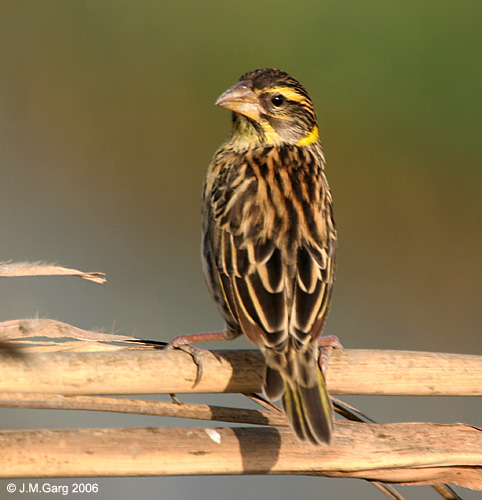Black-throated Weaver
From Wikipedia, the free encyclopedia
Order: Passeriformes
Family: Ploceidae
[Photo] Black-breasted Weaver (Ploceus benghalensis) at Hodal in Faridabad District of Haryana, India. Date 16.11.06. Author: J.M.Garg (http://commons.wikimedia.org/wiki/User:J.M.Garg). Copyright (C) 2006 J. M. Garg
Permission is granted to copy, distribute and/or modify this document under the terms of the GNU Free Documentation License, Version 1.2 or any later version published by the Free Software Foundation; with no Invariant Sections, no Front-Cover Texts, and no Back-Cover Texts. A copy of the license is included in the section entitled "GNU Free Documentation License". |
The Black-throated Weaver, also known as the Bengal Weaver or Black-breasted Weaver (Ploceus benghalensis), is a weaver resident in the northern river plains of the Indian subcontinent. Like the other weavers, the males build an enclosed nest from reeds and mud, and visiting females select a mate at least partially based on the quality of the nest.
Distribution
Resident or local migrant, endemic to South Asia.
From NWFP to Indus Valley in Pakistan to the Gangetic Plains of northern India, to Assam and the Northeast and Bangladesh; commonly seen in the Himalayan terai; patchy to the south in Gujarat and Andhra Pradesh.
Local Names: Hindi: Sarbo baya, Bengali: Shor baJa, Kantawala baya.
Description
Size: Sparrow (ca. 15cm)
Appearance: Male in breeding plumage has brilliant golden-yellow crown, white throat and a black band separating it from the fulvous-white underparts. In non-breeding male and female, crown brown like rest of upper plumage; black pectoral band less developed. A prominent supercilium, a spot behind ear, and narrow moustachial streaks, pale yellow. Flocks about cultivation and around reedy margins of tanks and jheels (shallow lakes), or extensive tall grass areas.
Behaviour: Polygynous; colonial; on the whole similar to those of the Baya and Streaked Weavers.
Courtship: Male constructs the nest single-handedly, with a group of females visiting it during late construction stage, jumping on the helmets and tugging and testing, presumably for strength. If a female appears interested, the male bows low before her, presenting golden crown at her. Flaps wings deliberately and sings softly tsi-tsisik-tsisik-tsik-tsik like chirp of cricket or subdued squeaking of unoiled bicycle wheel. Once female agrees and permits copulation, he quickly finishes the rest of the nest, and she lays eggs inside; he immediately commencing on a second nest nearby to attract other females, and occasionally a third, very rarely even a fourth. Nests not accepted by females may be torn down by the builder himself.
Nesting
Season: June to September
Nest: Similar to the Streaked Weaver; somewhat smaller and normally with shorter entrance tubes. Built in reed-beds in marsh, often moonj or kans (Saccharum spontaneum), with some of the growing reeds incorporated into the dome as support. Entrance tube is somewhat shorter than Baya weavers (up to about 25cm). At the 'helmet' stage of construction a quantity of wet mud or cowdung is daubed thickly along the edge, with bright coloured scarlet or orange flowers or flower petals (Lantana, Lagerstroemia) incorporated; observations suggest that this is part of the courtship rituals and exercise a direct influence on the reactions of the visiting female, both for this species and the Streaked Weaver.
Colony: Singly or in scattered groups of 4 or 5; sometimes larger colonies.
Eggs: 3 or 4, white, indistinguishable from those of the other two weavers.
http://en.wikipedia.org/wiki/Bengal_Weaver
| The text in this page is based on the copyrighted Wikipedia article shown in above URL. It is used under the GNU Free Documentation License. You may redistribute it, verbatim or modified, providing that you comply with the terms of the GFDL. |
|

